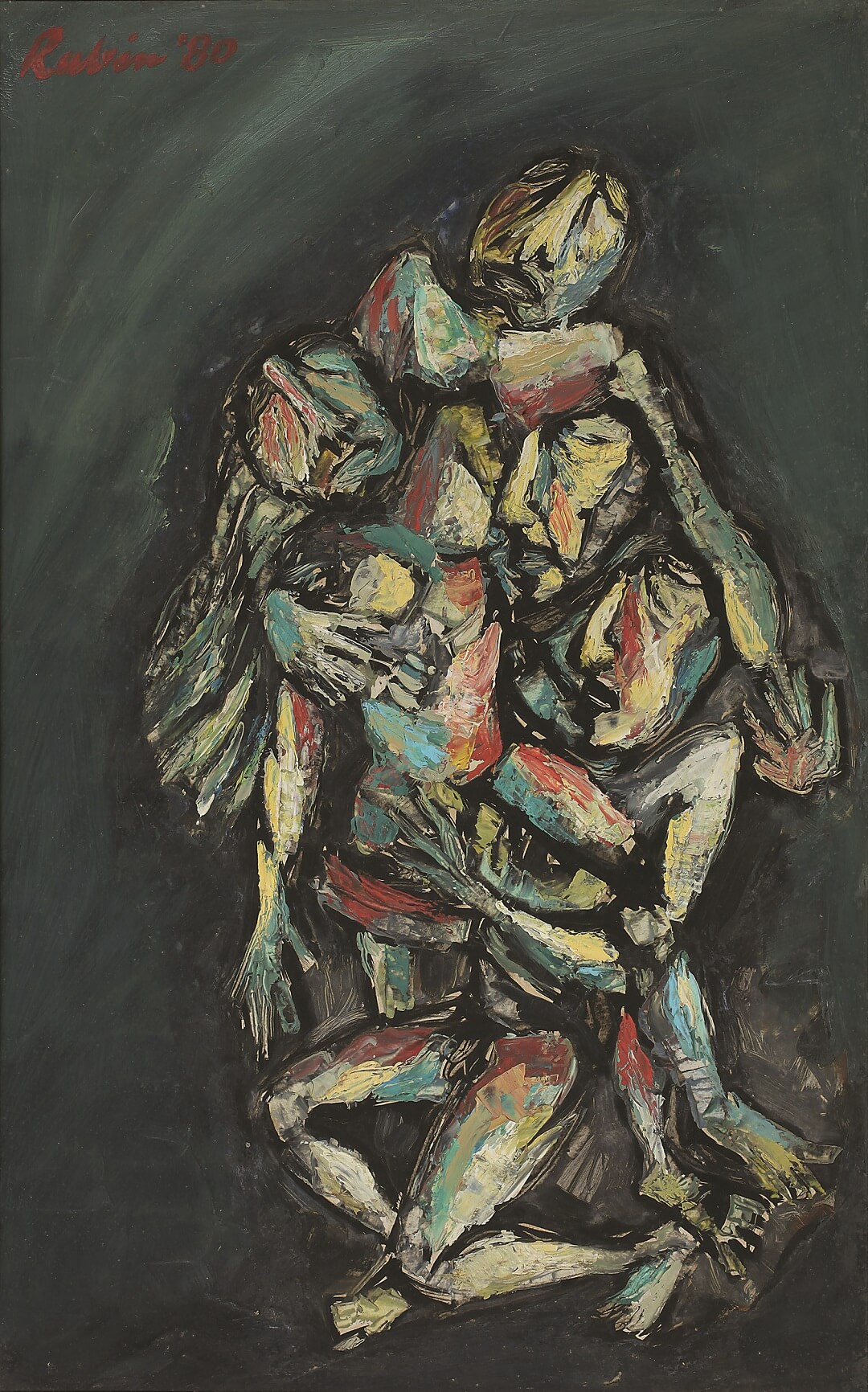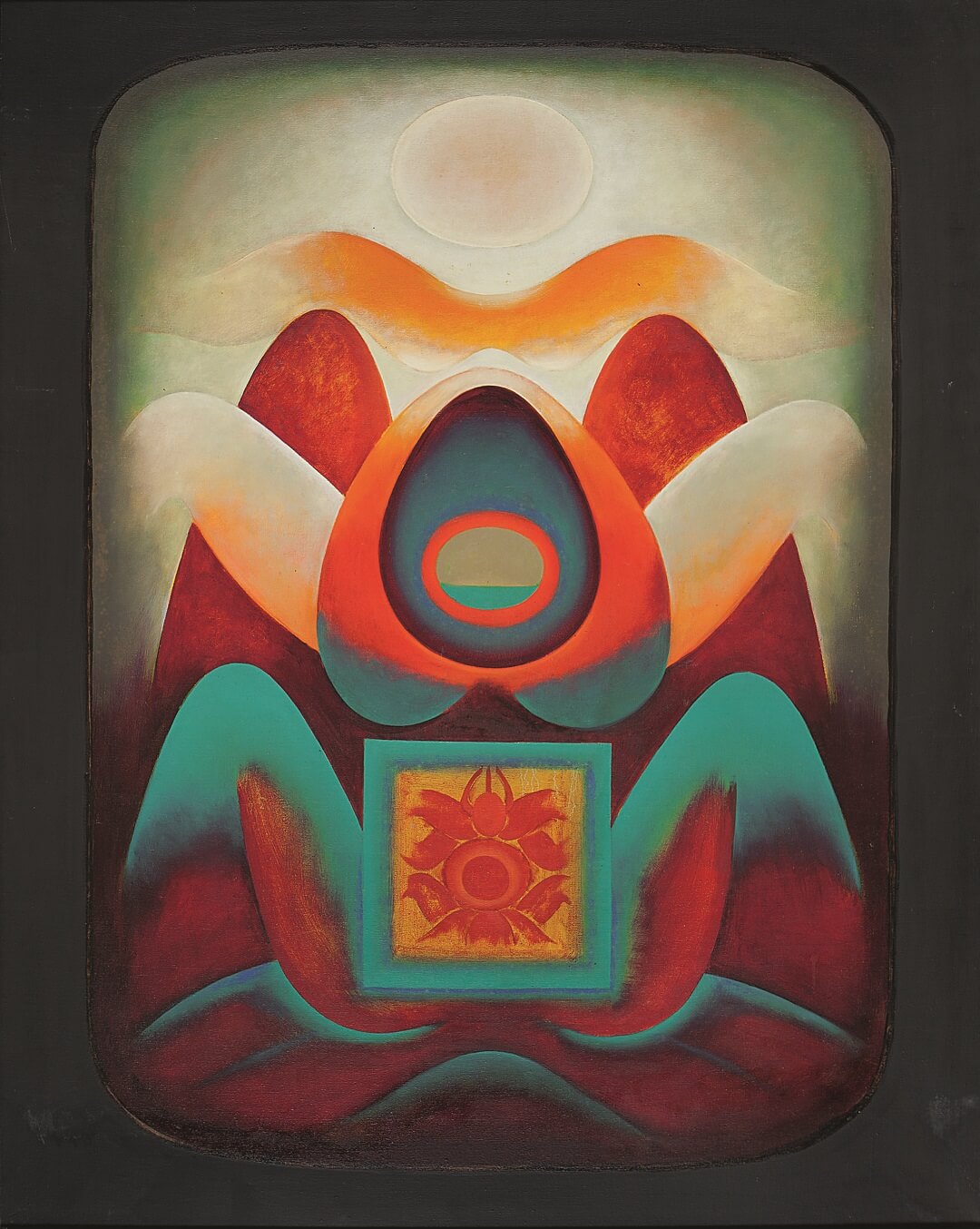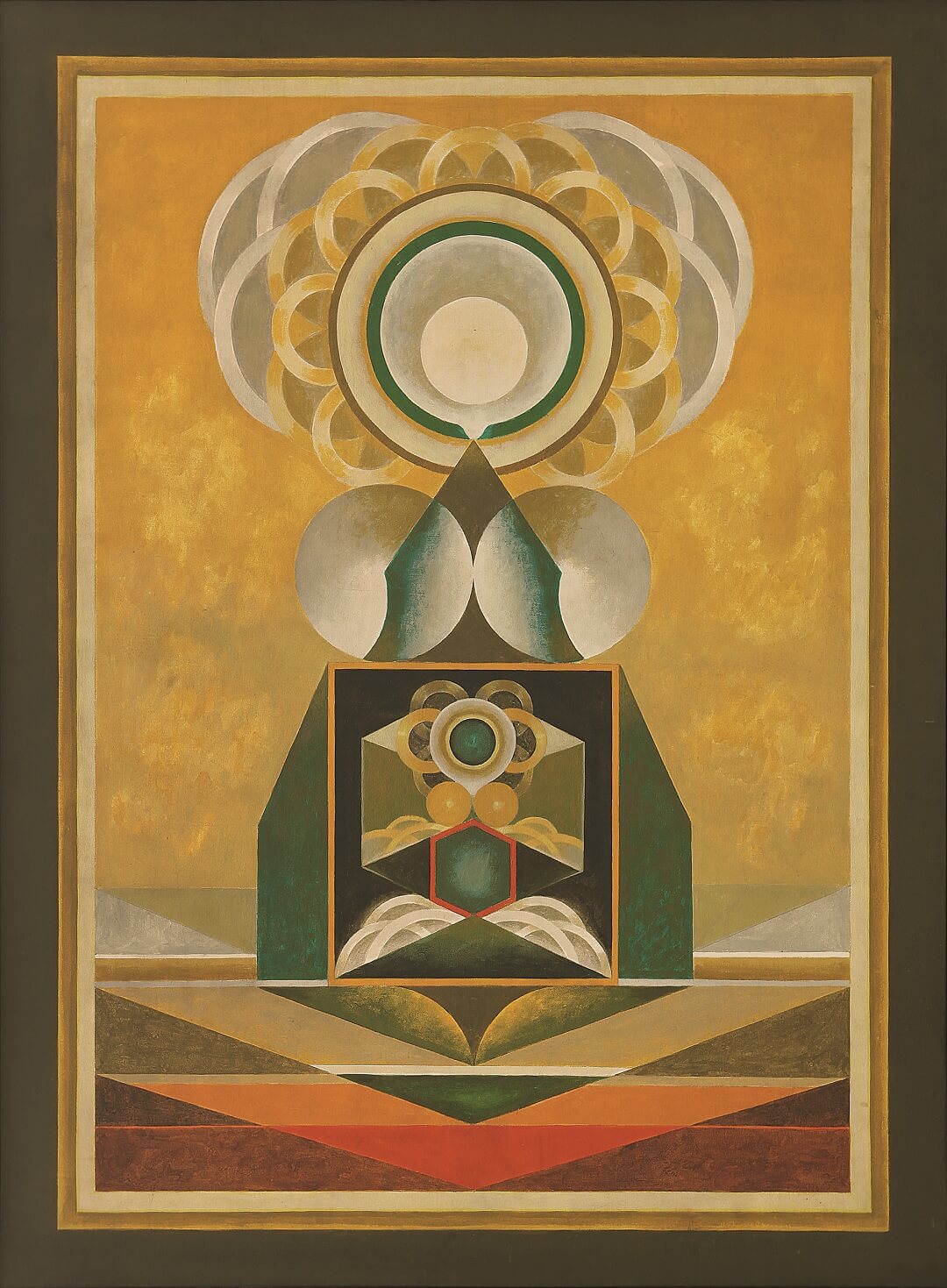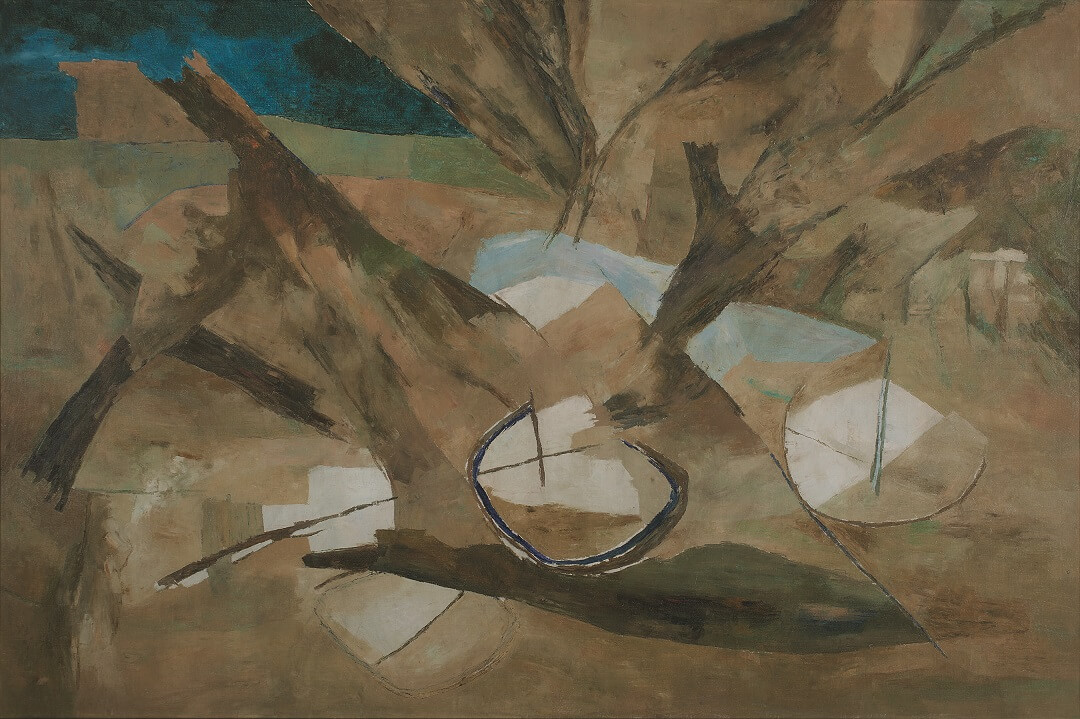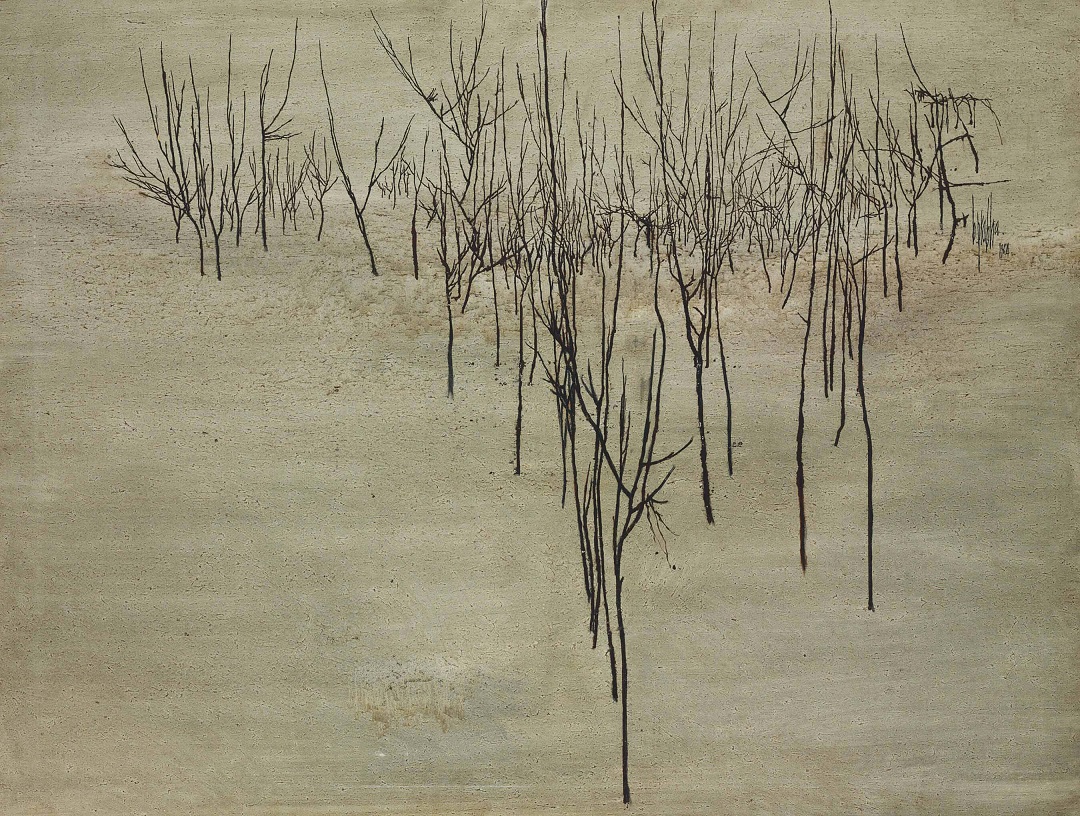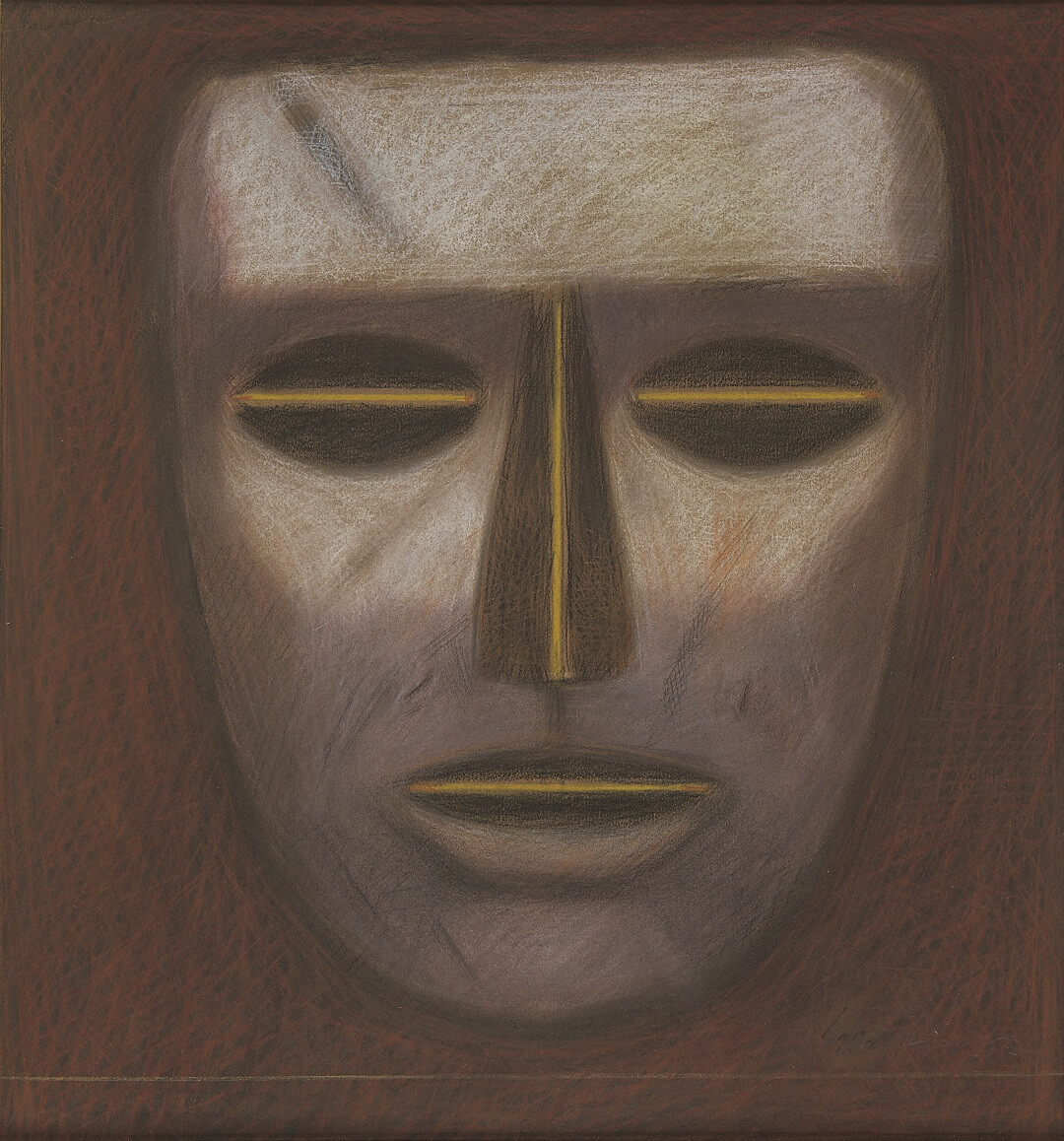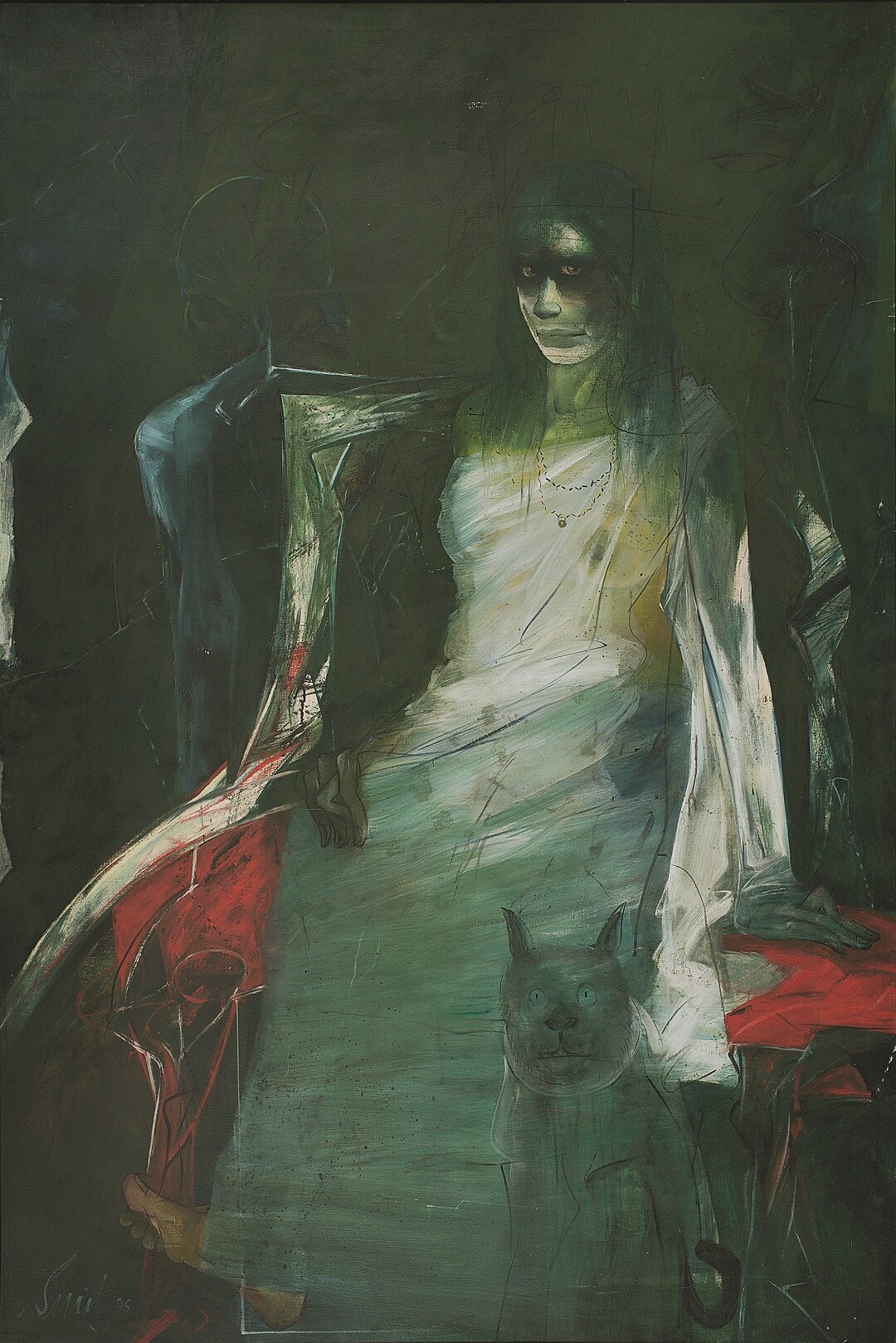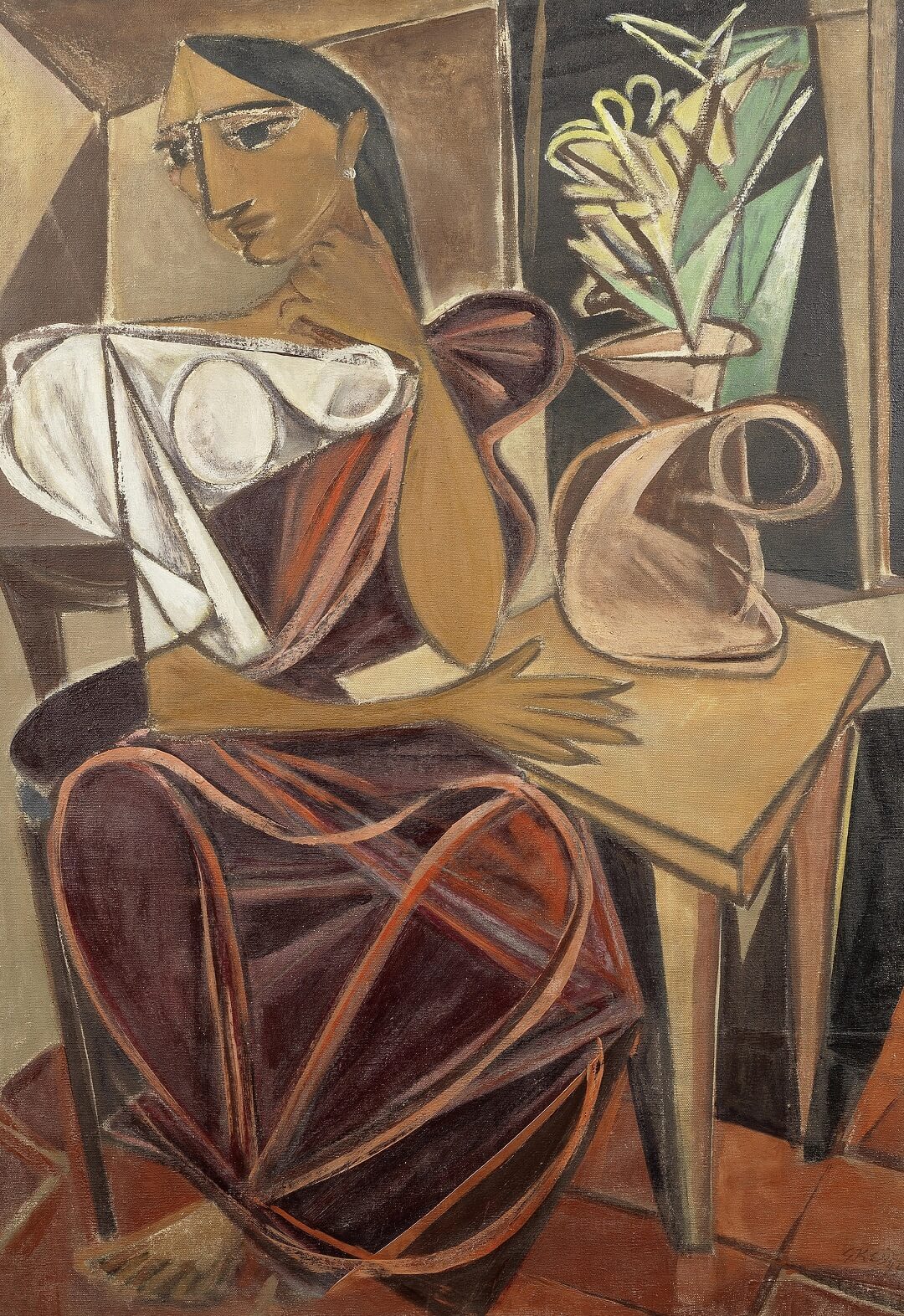India Modern: Narratives from 20th Century Indian Art
India Modern: Narratives from 20th Century Indian Art
India Modern: Narratives from 20th Century Indian Art
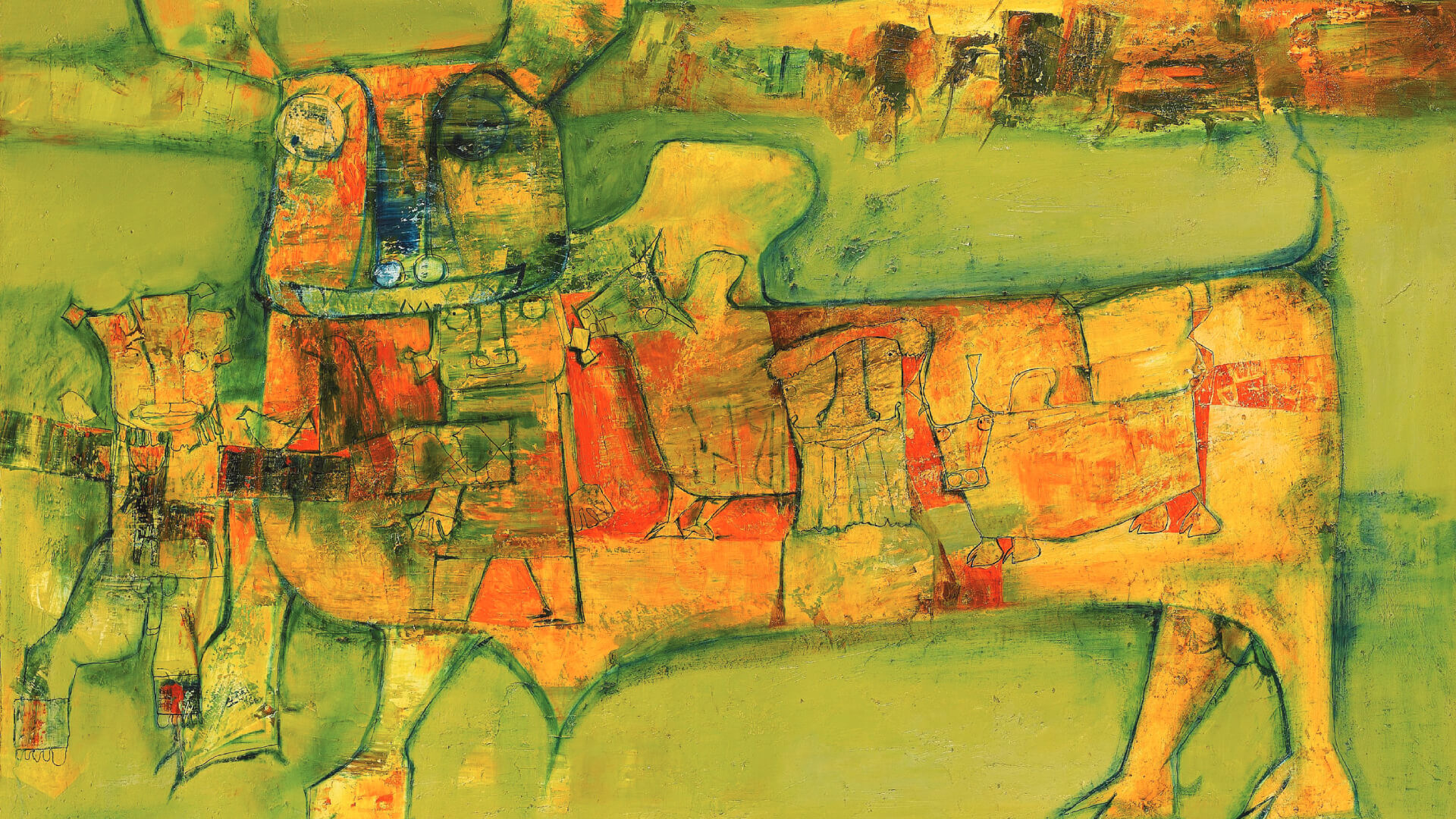
|
India Modern: Narratives from 20th Century Indian Art Lalit Kala Akademi Chandigarh, 15 Sep – 7 Oct 2017 An exhibition by DAG Sultan Ali Festival Bull Oil on canvas |
|
This exhibition takes us on a journey into the lives and works of artists from a diverse range of traditions and practices. Despite differences in technique, philosophy and politics, they are united by an attempt to forge a new language of Indian art which rebels against existing visual vocabularies while seamlessly combining influences from European modernism and the rich history of visual arts from South Asia. This assimilation is achieved in different ways. From M. F. Husain’s figurative renditions of Indian deities to the many languages of abstraction developed by artists like Ram Kumar, Ganesh Haloi and others—we see artists responding variously to the socio-cultural problems of a post-colonial nation. |
|
Ambadas Untitled Oil on canvas |
|
Towards Simplicity: Experiments in Primitivist Art The quest to find a formal and philosophical alternative to Western conventions of art pushed Indian artists to re-examine their own cultural history and legacy. Primitivism was one such alternative visual language. While its expression in the works of individual artists are unique, the style draws from the perceived simplicity of tribal art and culture. It combines the wish to identify with supposedly ‘primitive’ elements of society and the formal desire to simplify the compositional process. |
|
Himmat Shah Untitled (Head) Terracotta |

J. Sultan Ali
Tribal Myth
Oil on canvas
Sultan Ali drew inspiration from tribal art while looking for an alternative to European forms and conventions he had been trained in. He was deeply inspired by the works of anthropologist Verrier Elwin on cultures that used symbols in fresh ways, distinct from the norms of classical art. Taking his cue from the teachings of Elwin he engaged extensively with tribal communities at Bastar to perfect his style. The colours in this exuberant work speak of the brief season of spring that precedes the searing heat of an Indian summer. The two forms, possibly male and female, could have been imagined after the votive wooden figures carved out of fragrant sandalwood and offered at temples, or even the grain-goddesses fashioned out of dried rice stalks. |
Rabin Mondal
Untitled
Rabin Mondal
Untitled
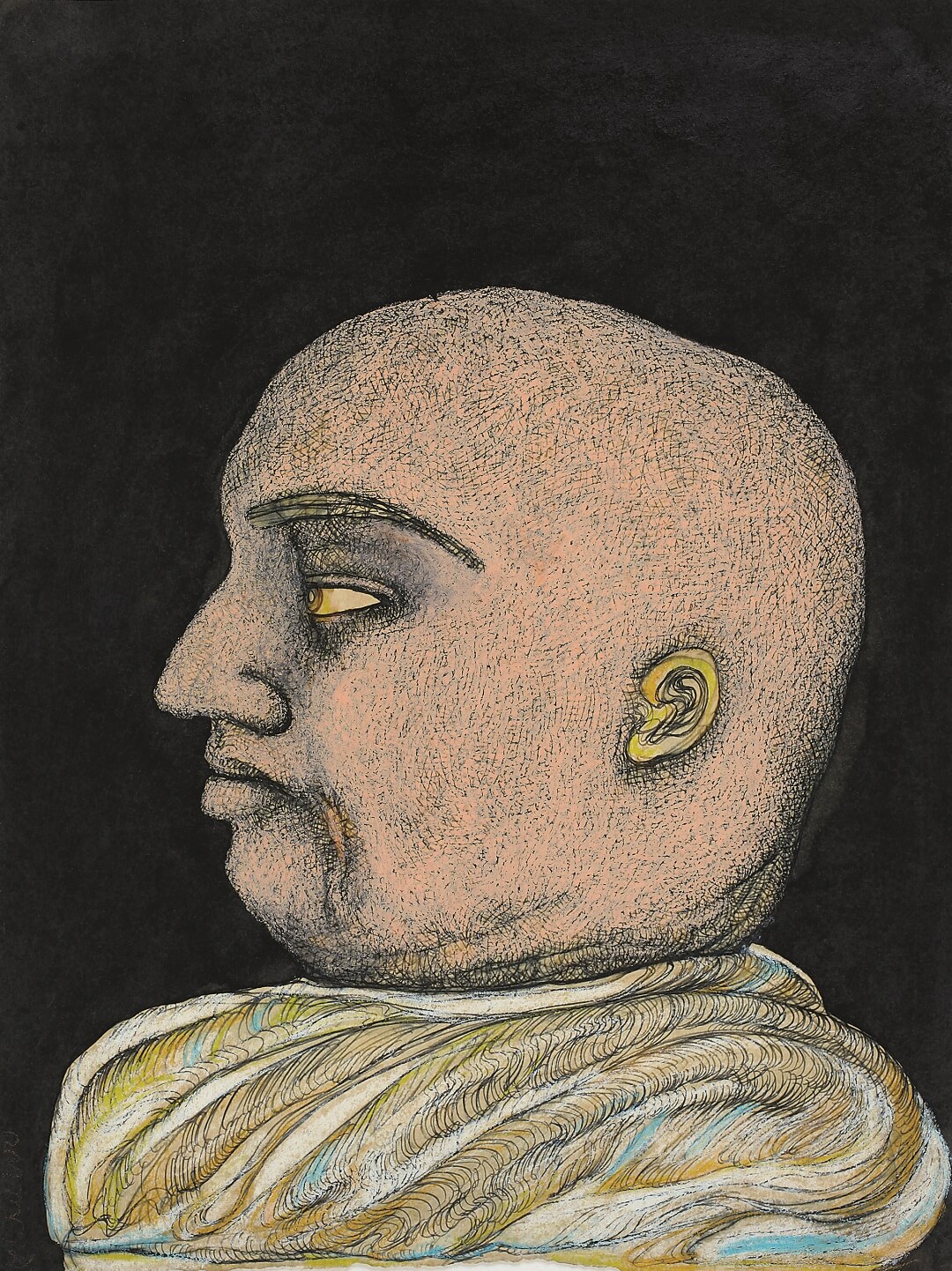
Jogen Chowdhury
Untitled
Pen and ink and pastel on cardboard
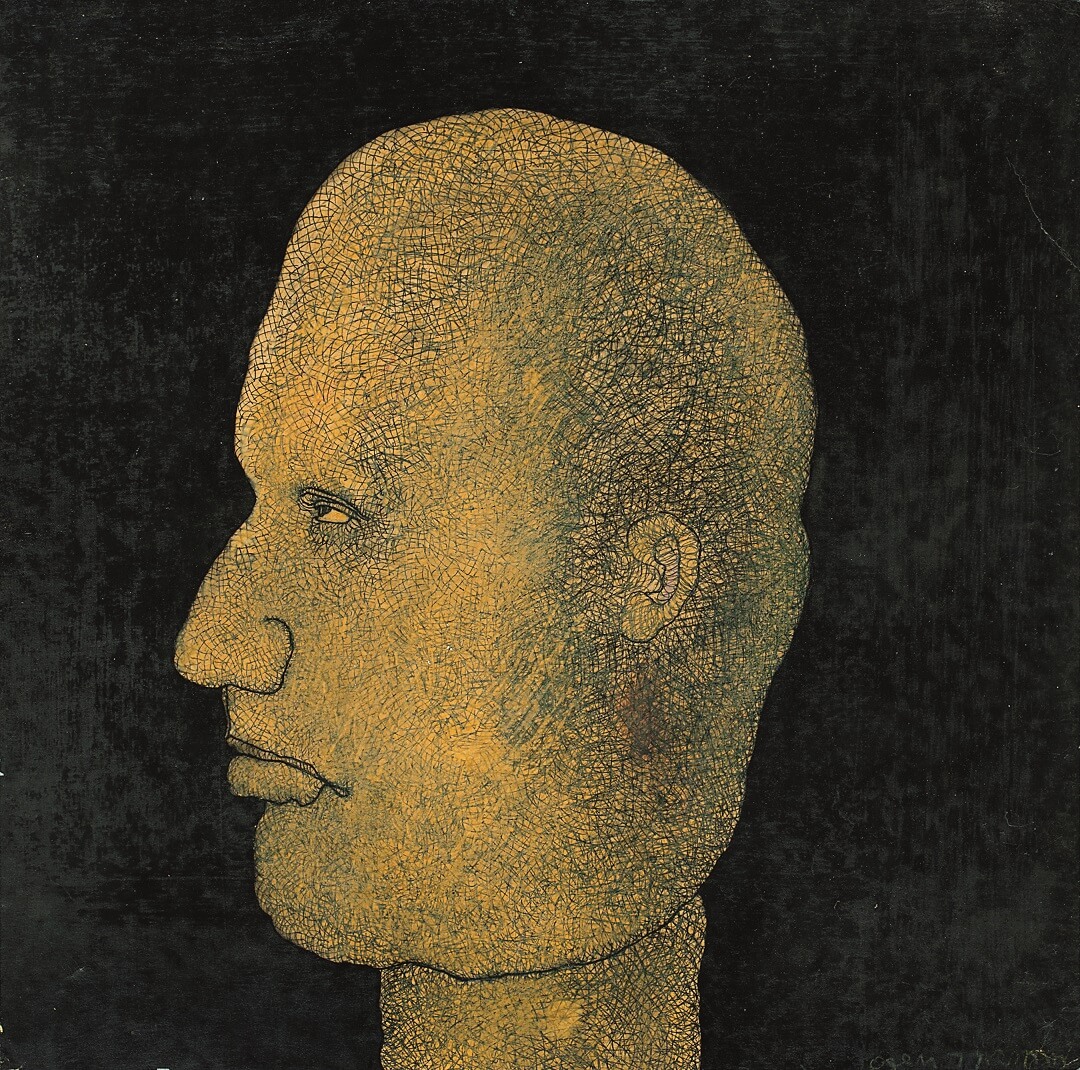
Jogen Chowdhury
Portrait of a Musician
Pen and ink and oil pastel on paper
Hailing from a zamindari family of Faridpur in present day Bangladesh, Jogen Chowdhury moved to Calcutta following Partition. The human body is a crucial unit in Chowdhury’s vocabulary. Often placing it against a dark, vacant background, he does not dwell on the specificities of place or environment; instead, he projects anguish onto the solitary figure through his gestural mark-making. Part of a series of portraits of Indian men and women that Jogen Chowdhury executed in the late 1970s and early '80s, Portrait of a Musician features a bald, corpulent man in profile dominating the frame. His head resembles a plump fruit, ripe for the picking, while the folds of his garment snake across his shoulder. As in many of his works, the figure is offset by a dark void, thereby enhancing its inherent luminosity. |
|
Searching for Light: Neo-Tantrism as a Language of Art Various traditions of mysticism have inspired Indian artists over the centuries. One such significant philosophy that drove a group of artists to formulate a new visual language was Tantra. The union of two primal cosmic forces—Shiva and Shakti—lies at the heart of Tantric beliefs and practices. The customs and rituals seek to break taboos around sexuality, and its tenets are visually expressed in sculptures and scrolls of ancient India through the recurring symbols of lingam and yoni. Even though ‘neo-Tantrism’ derives its forms from Tantric art, it developed as a visual and aesthetic exercise independent of scriptures. Its practitioners are united in their attempt to forge a language of abstractionism outside the available models from the West. Formally, neo-Tantric art seeks to go beyond the figurative and develop a common set of recognisable universal forms which communicate the artist’s vision. |
|
Sohan Qadri Untitled Ink and dye on handmade paper |
G. R. Santosh
Shiva Shakti Series
G. R. Santosh
Untitled
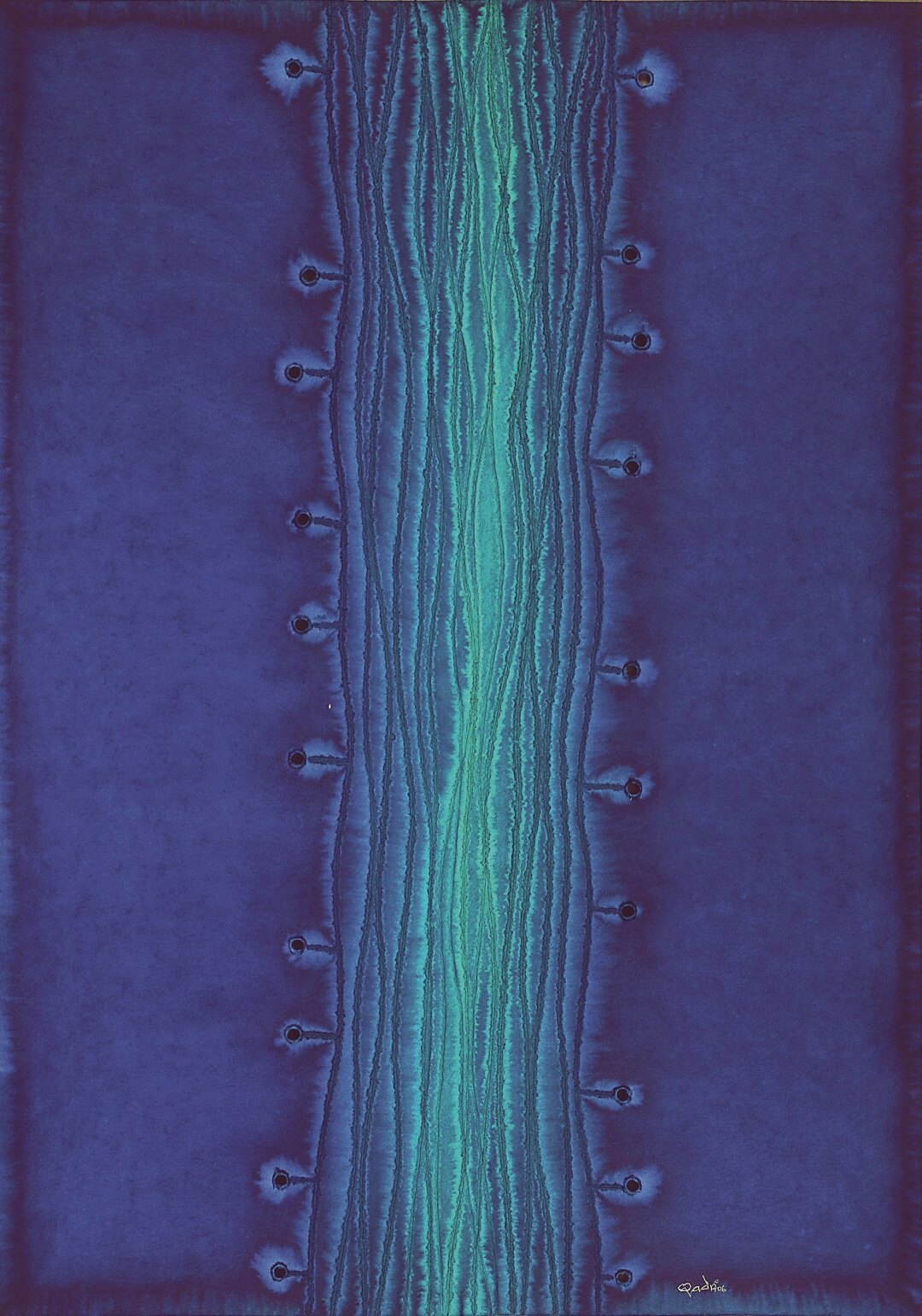
Sohan Qadri
Untitled
Ink and dye on paper
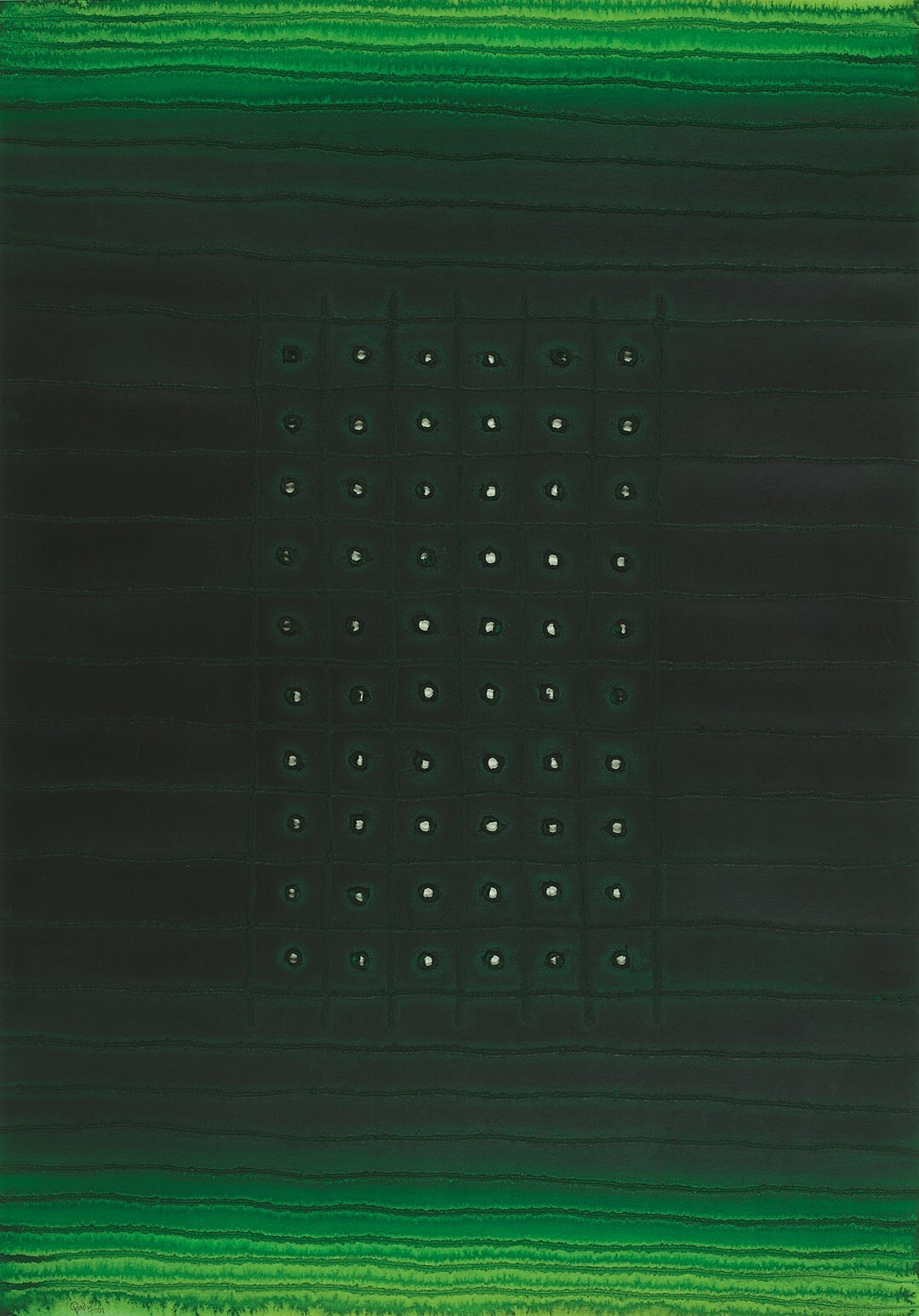
Sohan Qadri
Untitled
Ink and dye on paper
Born to a wealthy farming family in the village Chachoki in Punjab, Sohan Qadri came across two spiritualists living on the family farm at the age of seven—Bikham Giri, a Bengali tantric-vajrayan yogi, and Ahmed Alihah Qadri, a Sufi. Both gurus had a tremendous impact on young Qadri and taught him spiritual ideals through meditation, dance and music. His association with them heralded a lifelong commitment to spirituality and art. Tantra scholars have held that Sohan Qadri’s output was unique. Unlike other artists, working within this tradition, who responded to light as a visual and spiritual concept, Qadri attempted to tune into the reverberations of sound produced during a ritual chanting. |

Biren De
Untitled
Oil on canvas
Hailing from Faridpur, Bangladesh, Biren De went to Calcutta where he completed his graduation in fine arts from the Government College of Art in 1949. From the late '50s, his figurative compositions began to fragment, turning into free shapes and units. Around this time De, along with some of his contemporaries, drew away from the styles of their predecessors and his imagery began evoking a metaphysical introspection through recurrent symbols of the lotus, the sun, the wheel and bursting seeds. His paintings captured the implosion of energy devoid of any agitated movement; only a blinding effulgence at its heart. The overall effect of De’s Tantra works is one of stillness, a hypnotising contemplation of serenity that the artist induces in the viewer. |
|
Scapes of the Mind: Re-imagining the Landscape Landscape is one of the most commonly practised forms of art, but modernists like Ganesh Haloi stretch the possibilities of this genre to its utmost, exploring non-realistic modes of representing landscape which communicate the artist’s internal vision and interpretation of space. |
|
Avinash Chandra City of Churches, Belfast Oil on board |
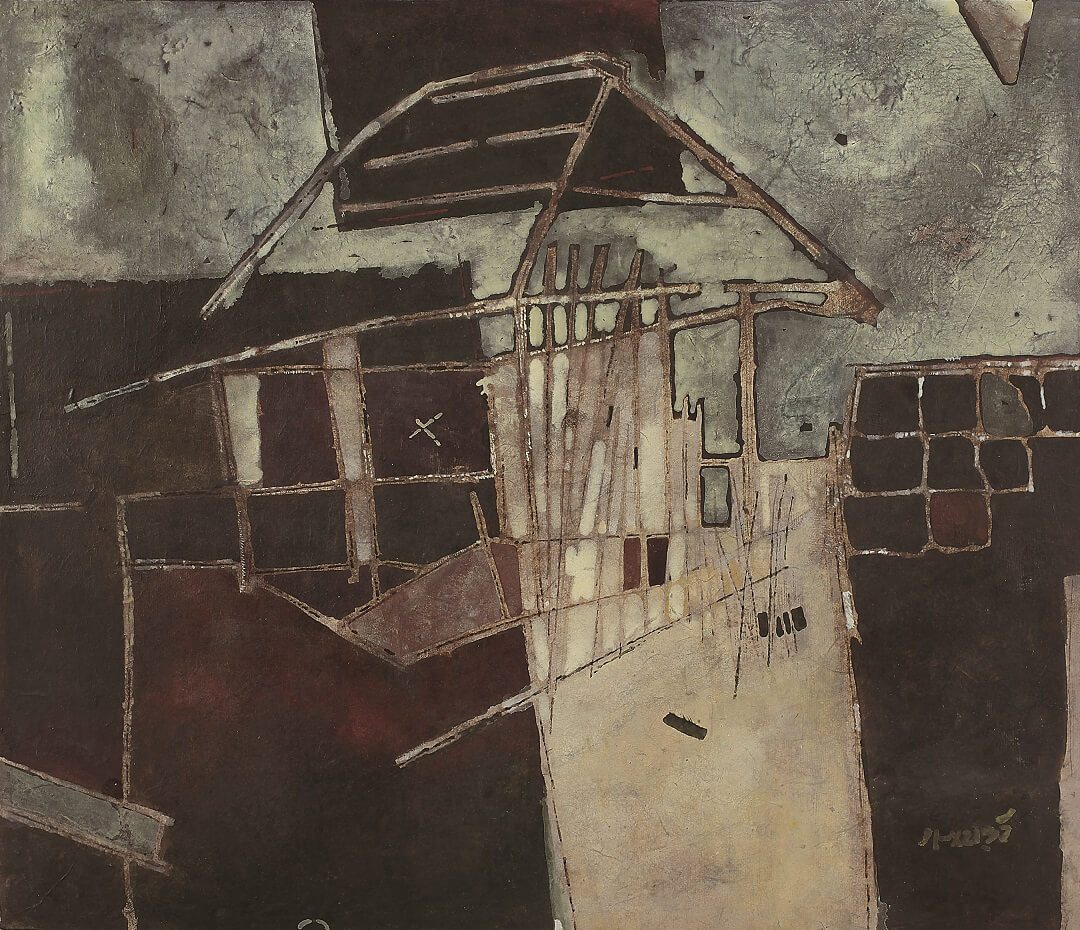
Ganesh Haloi
Untitled
Gouache, watercolour and acrylic on mount board
Born in Jamalpur in what is now Bangladesh, Ganesh Haloi was forced to migrate to West Bengal in the aftermath of Partition. Trained in the Government Art College, he swiftly acquired eminence as a landscape painter by the mid '70s. But his style significantly transformed with the Metascape Series, where he began to build up an abstract way of depicting nature that goes beyond visual documentation but conveys the poetry of nature. This Untitled work is perhaps one of the rare instances where the artist tells us much through definitive forms. The skeletal structure of a hut stands in the middle of the canvas evoking simply, the memory of a dwelling. Few bits of tattered straw before the door remain as poignant markers of a time when this space was inhabited. |
Ram Kumar
Untitled
G. Prabha
Untitled (Landscape)
|
Encounters with the Subject: New Languages of Portraiture During the colonial period the art of portraiture was heavily influenced by European conventions of naturalism taught in government art colleges. After independence, the waves of social and political turbulence pushed Indian artists to new ways of imagining portraiture. The portraits tended to move away from naturalism and became more stylised, communicating the artist’s inner imagination of the subject. |
|
K. Laxma Goud Untitled Graphite, pencil colour and pastel |

F. N. Souza
Untitled
Oil on canvas
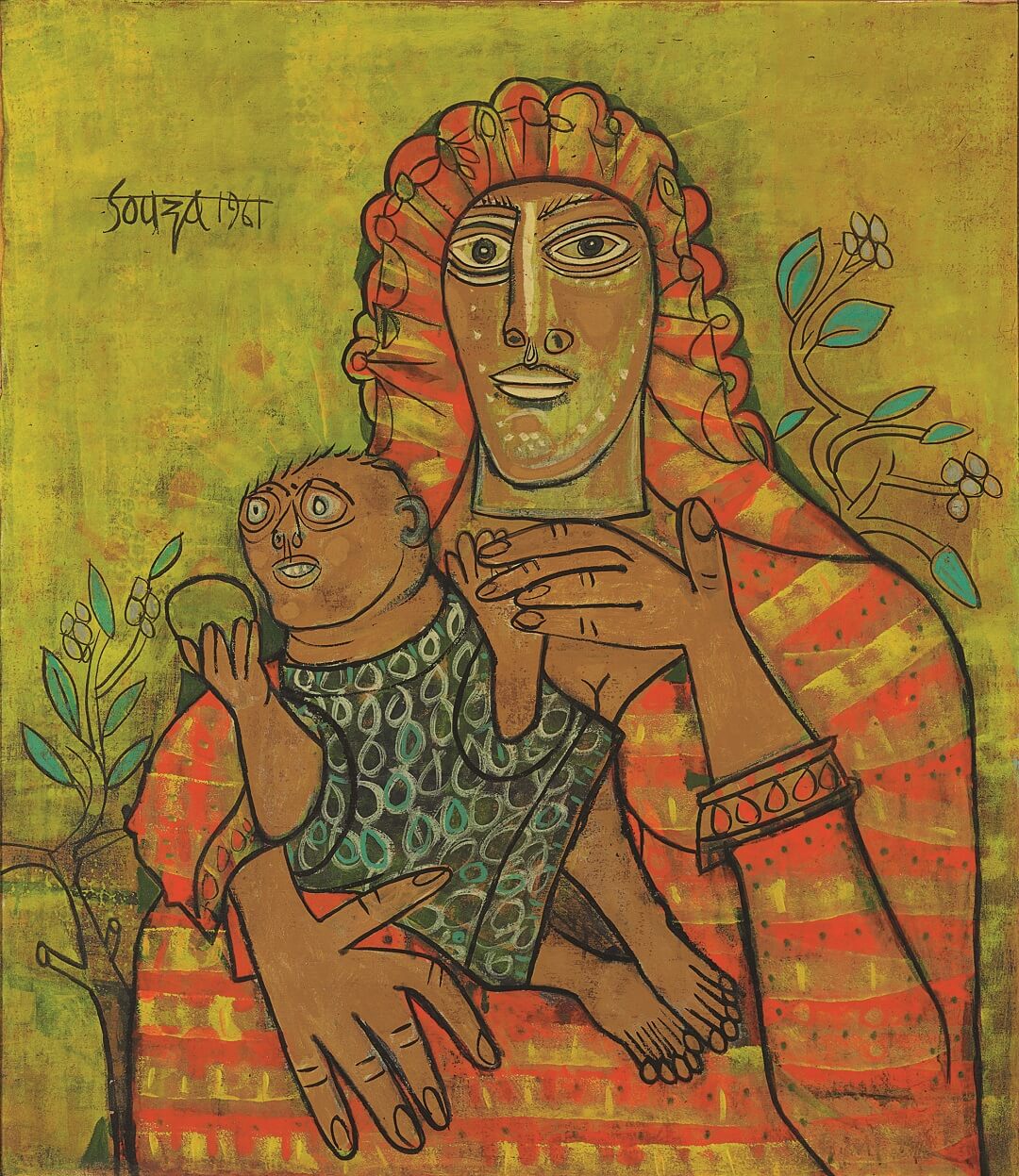
F. N. Souza
Mother and Child
Oil on canvas
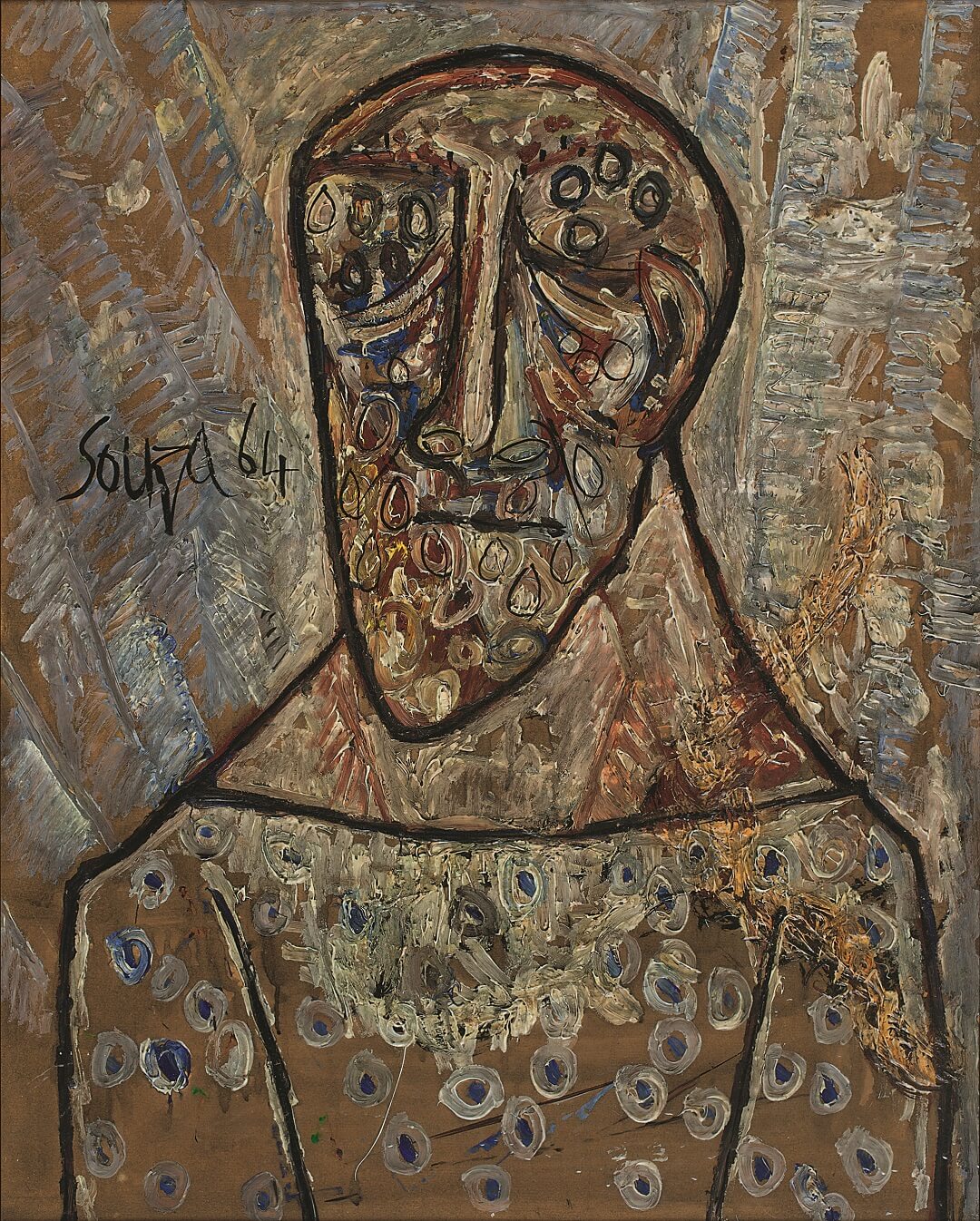
F. N. Souza
Homer
Oil on Masonite board
F. N. Souza was the founder member and spokesperson of the Progressive Artists Group. From nudes to landscapes and portraits—he painted in every style and in every medium, even inventing ‘chemical alterations’, a method of drawing with the use of chemical solvent on a printed page without destroying the glossy surface. In this 1964 painting titled Homer, he draws from multiple traditions—expressionism and cubism combined with the style of Indian classical sculptures. The most liberty he takes in the portrait is the displacement of one eye, which could be an allusion to the poet’s inability to see the physical world while being able to view it internally from his perspective as a poet. |
Krishen Khanna
Untitled (Christ)
Ganesh Pyne
Untitled
|
The Artist as Critic Some artists expressed their anguish against injustice and suffering by using a combination of naturalistic tropes and satirical expressions to critique culture and society. Artists like Bikash Bhattacharjee, Sunil Das and Dharmanarayan Dasgupta practised in very different styles but used recognisable strategies to reflect on social problems of the time. |
|
Bikash Bhattacharjee Untitled (Prostitute) Oil on canvas |
Bikash Bhattacharjee
Untitled (Ceremony)
Sunil Das
Prostitute
Dharmanarayan Dasgupta
Untitled
|
Figurative art broadly refers to any artwork which features real objects or contains strong references to the real world. The term is primarily used to distinguish this style from abstraction on the one hand and realism on the other hand. Modern figurative art uses conventions and idioms similar to 20th century expressionism. This category is general enough to include a wide range of artists and their styles but here we explore some artists who introduced fresh perspectives to this form. Modern figurative art uses conventions and idioms similar to 20th century expressionism |
|
M. F. Husain Untitled (Nude) Oil on canvas |

M. F. Husain
Untitled (Tribal Women)
Oil on canvas
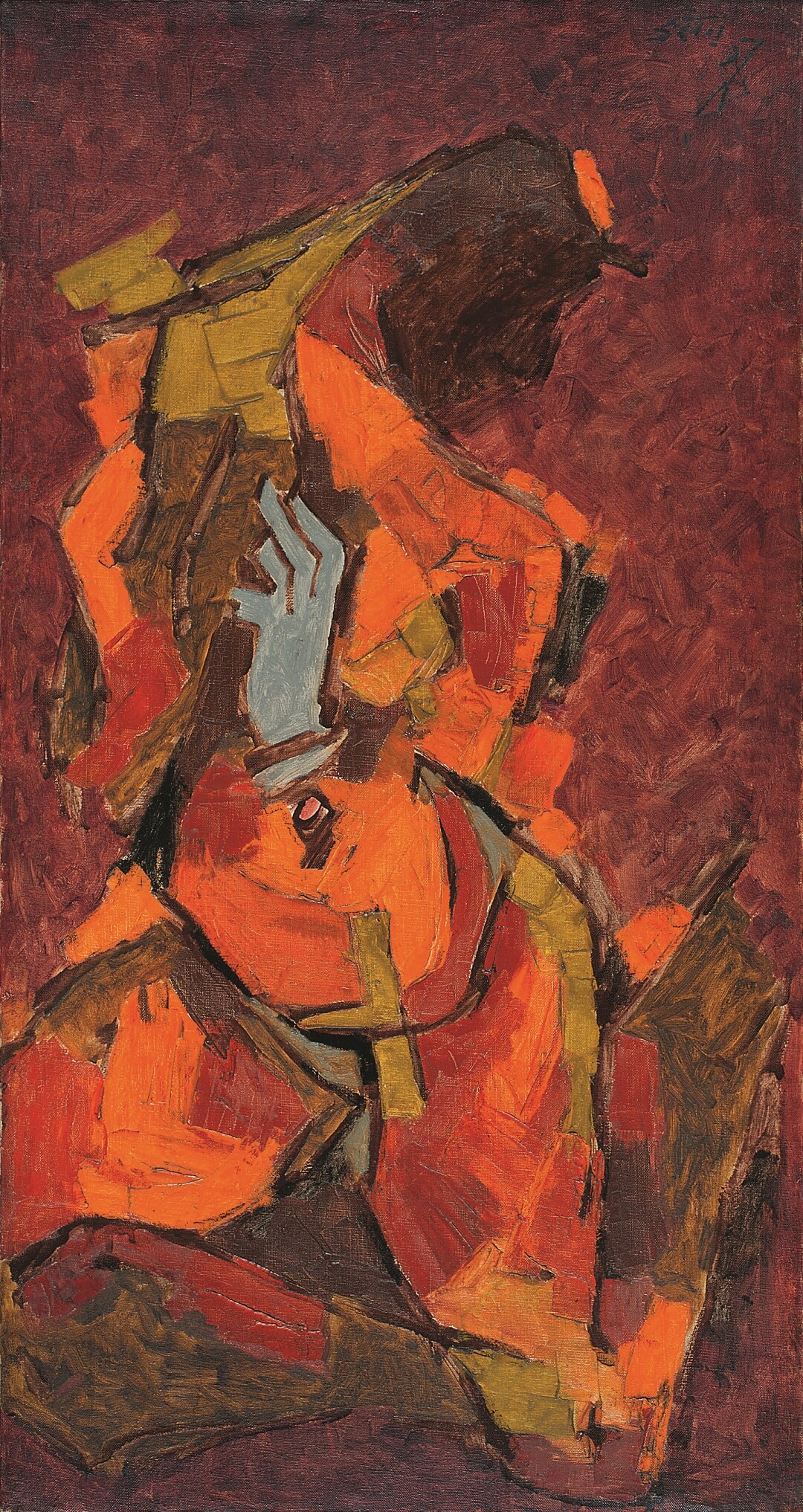
M. F. Husain
Untitled
Oil on canvas
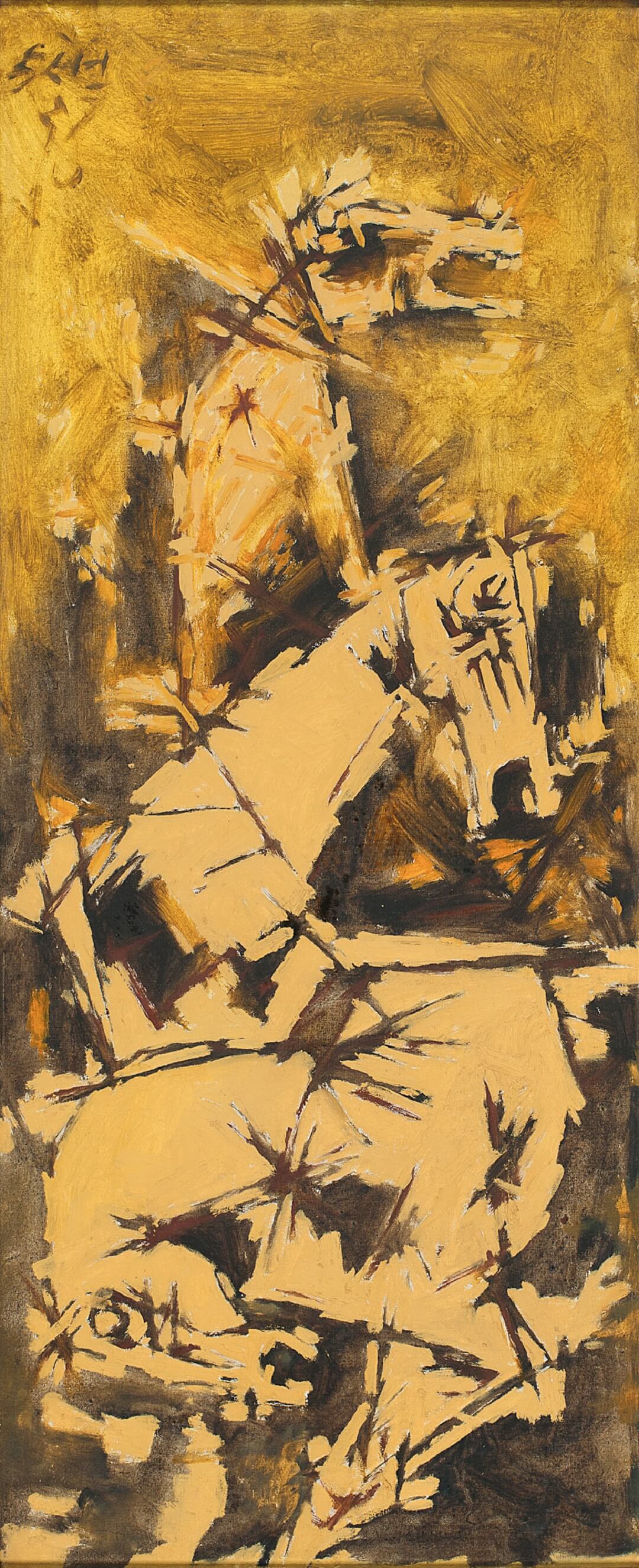
M. F. Husain
Untitled
Oil on canvas
The name M. F. Husain is synonymous with twentieth century Indian art. Born in Pandharpur, Maharashtra, Husain came to Bombay in 1937 determined to become a painter, where he slept on the footpath and painted under the streetlights. A self-taught artist, he began his career painting cinema posters, hoardings, toys and furniture. Pictorially, there is usually an absence of intimacy in his imagery. This Untitled (Tribal Women) stands as an exception. Three women, seen only from their torsos upward, are grouped close together as the one in front, in profile, speaks and the other two listen. She gestures with her left hand, and addresses them with some authority. The work is marked by Husain’s characteristic brushstroke defining the forms, features and limbs of the women, and seen equally in the textured, rich brown ground all around. |
George Keyt
Seated Woman with Flowers
Anjolie Ela Menon
Madonna of Meriweather Road
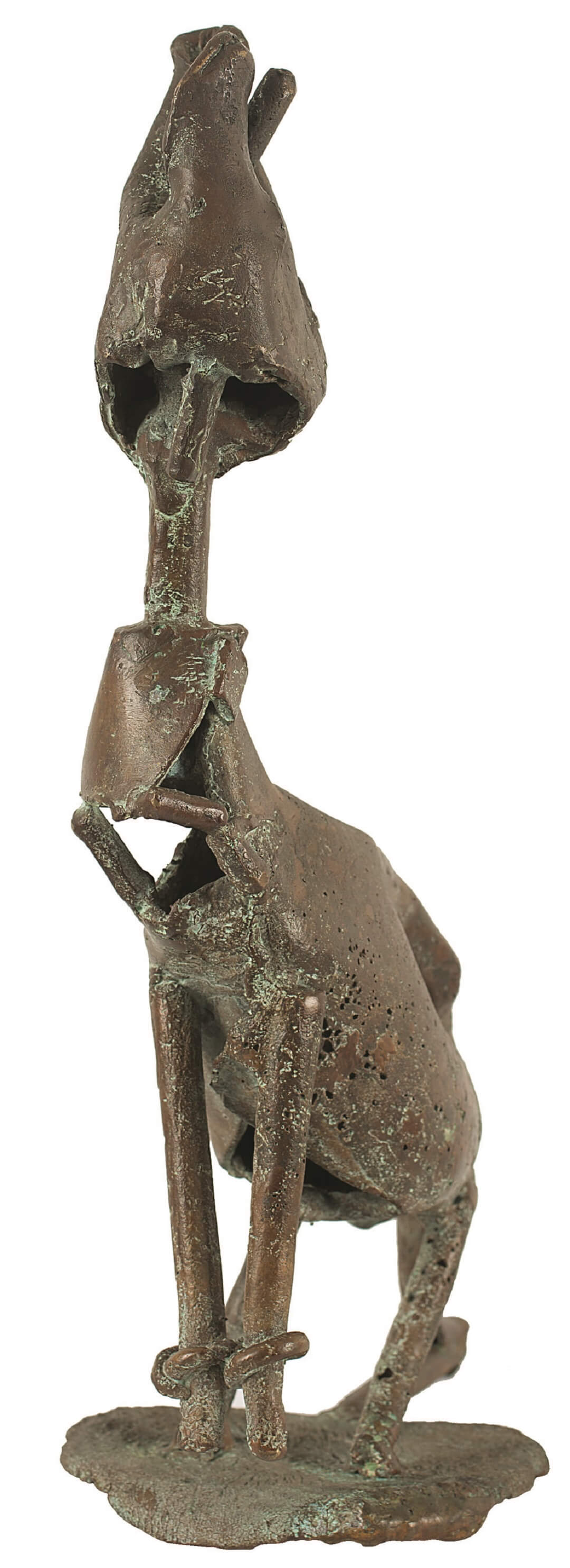
Somnath Hore
Untitled
Bronze
Somnath Hore was deeply influenced by the participatory, collective practices of contemporary artists like Chittaprosad. The 1943 Bengal famine and the Tebhaga peasant uprising in '46 permanently transformed his artistic vision, reappearing constantly in his works. Even though most of his sculptures were created during the '70s, they carry the lasting impact of the violence of partition. Whether large or small, his sculptures were characterised by a flair and freedom towards creating forms that reflected human anguish. The animal, which could be part horse, part dog, is an extension of the human condition, often expressing a greater sense of vulnerability due to its inability to speak. Its twisted and maimed limbs were motifs that enable the artist to express the victimhood of the downtrodden |
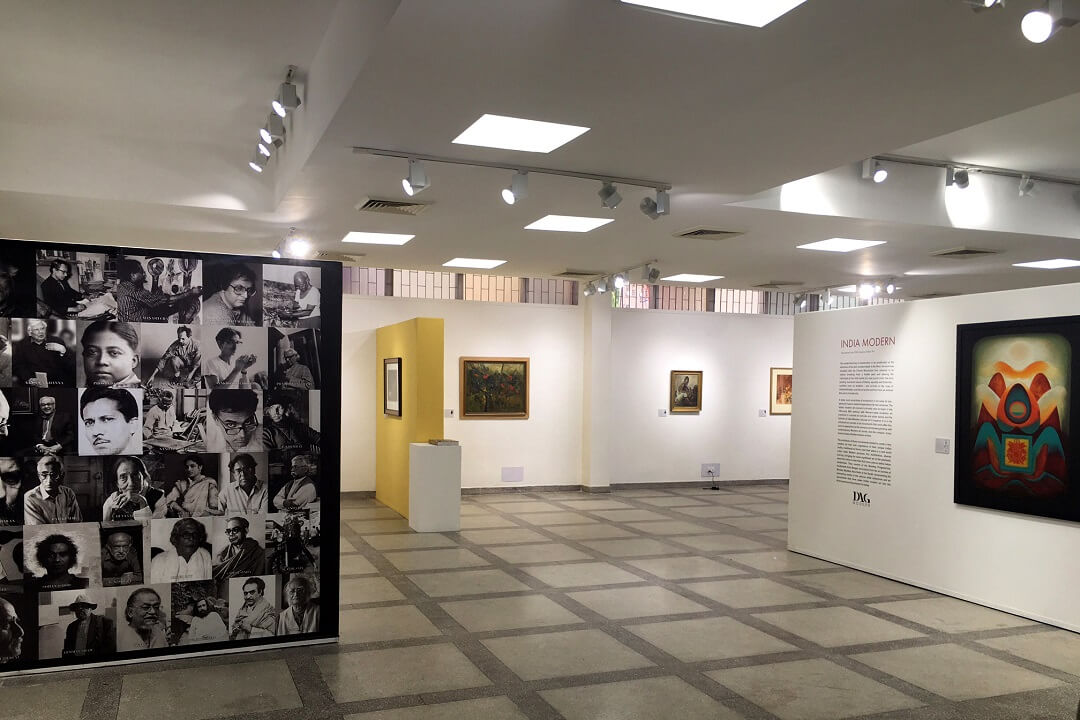
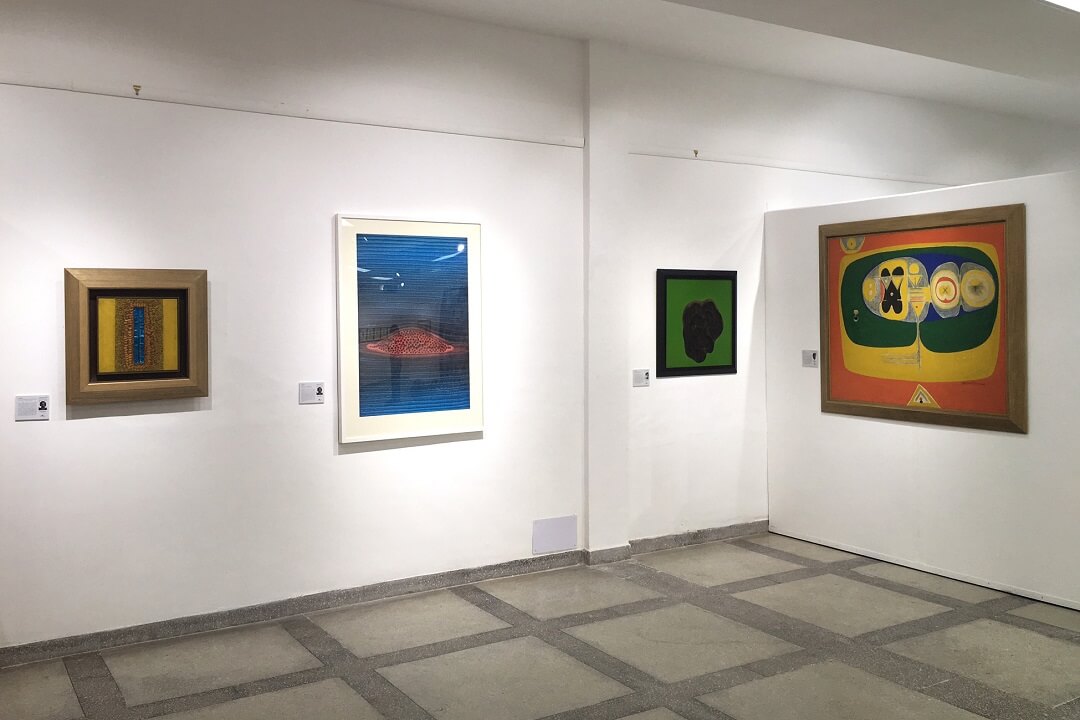
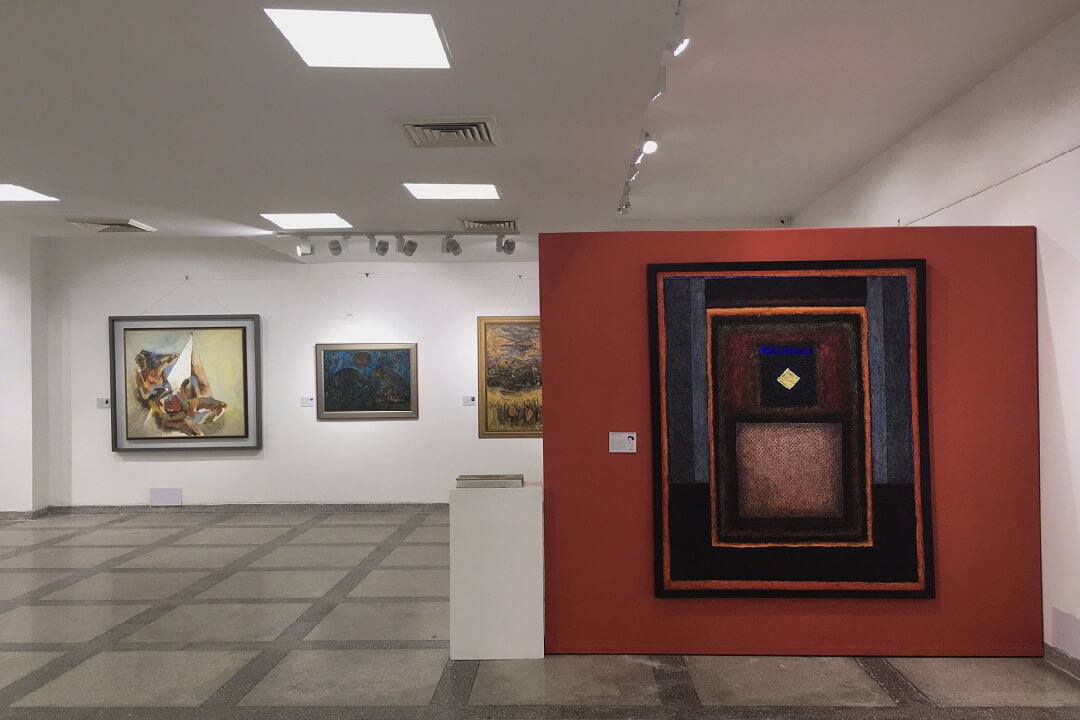
EXHIBITION VIEW'It’s a rare chance to get up, close and personal with the most significant art of the landmark Indian modernists, who have come to define Indian modernism as part of the exhibition, India Modern: Narratives from 20th Century Indian Art…As part of the exhibition, the effort is to get students of art, schoolchildren and people who love art, closer to the works, with curated walks, with experts talking about the styles, techniques, mediums, history of an art work and also sharing the artists’ philosophy and the contexts of the subject of the works.' 'India Modern Narratives from 20th century Modern Indian Art: Exhibition showcases 57 original artworks', Indian Express, 15 September 2017 |
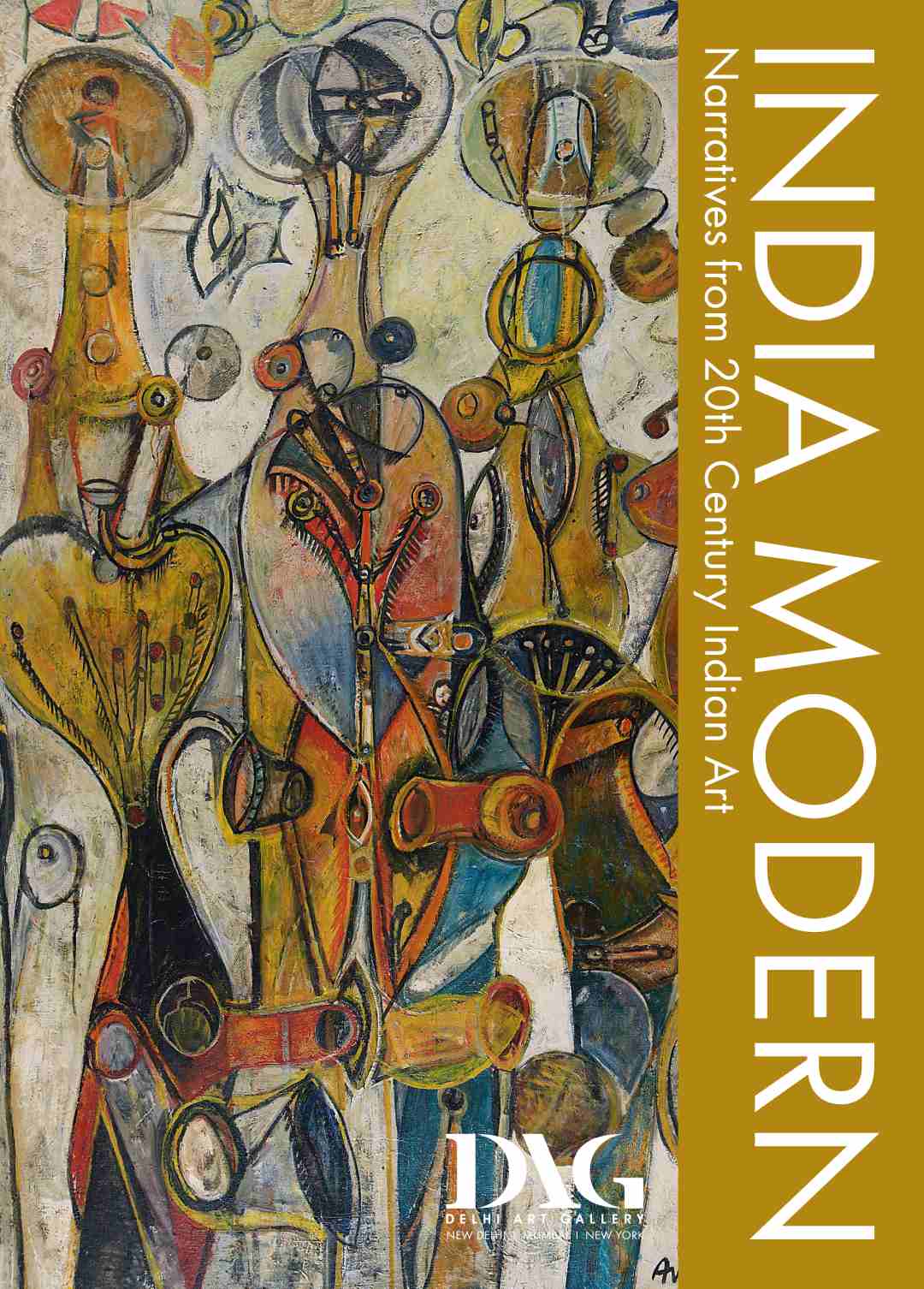
Presented by





